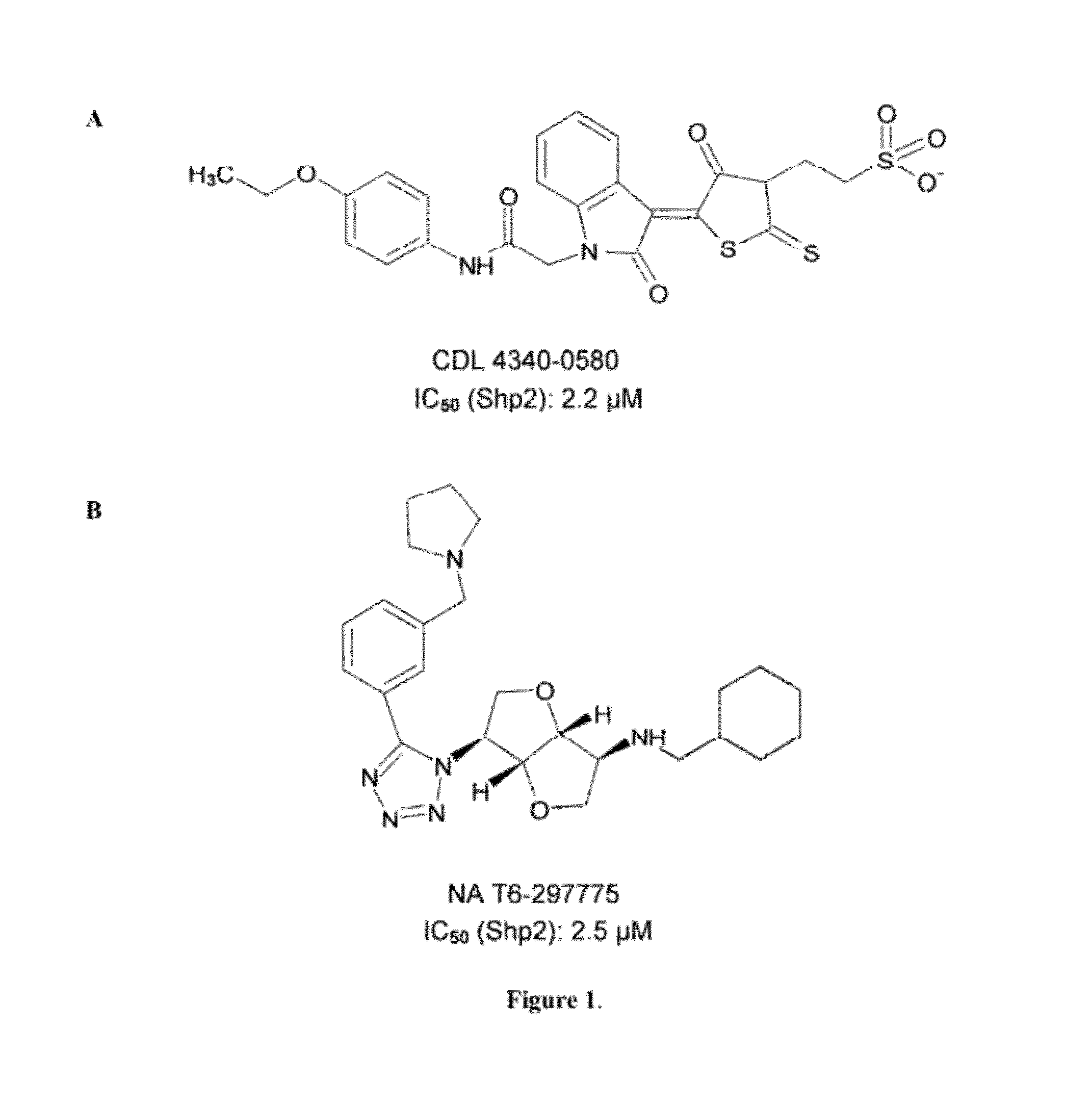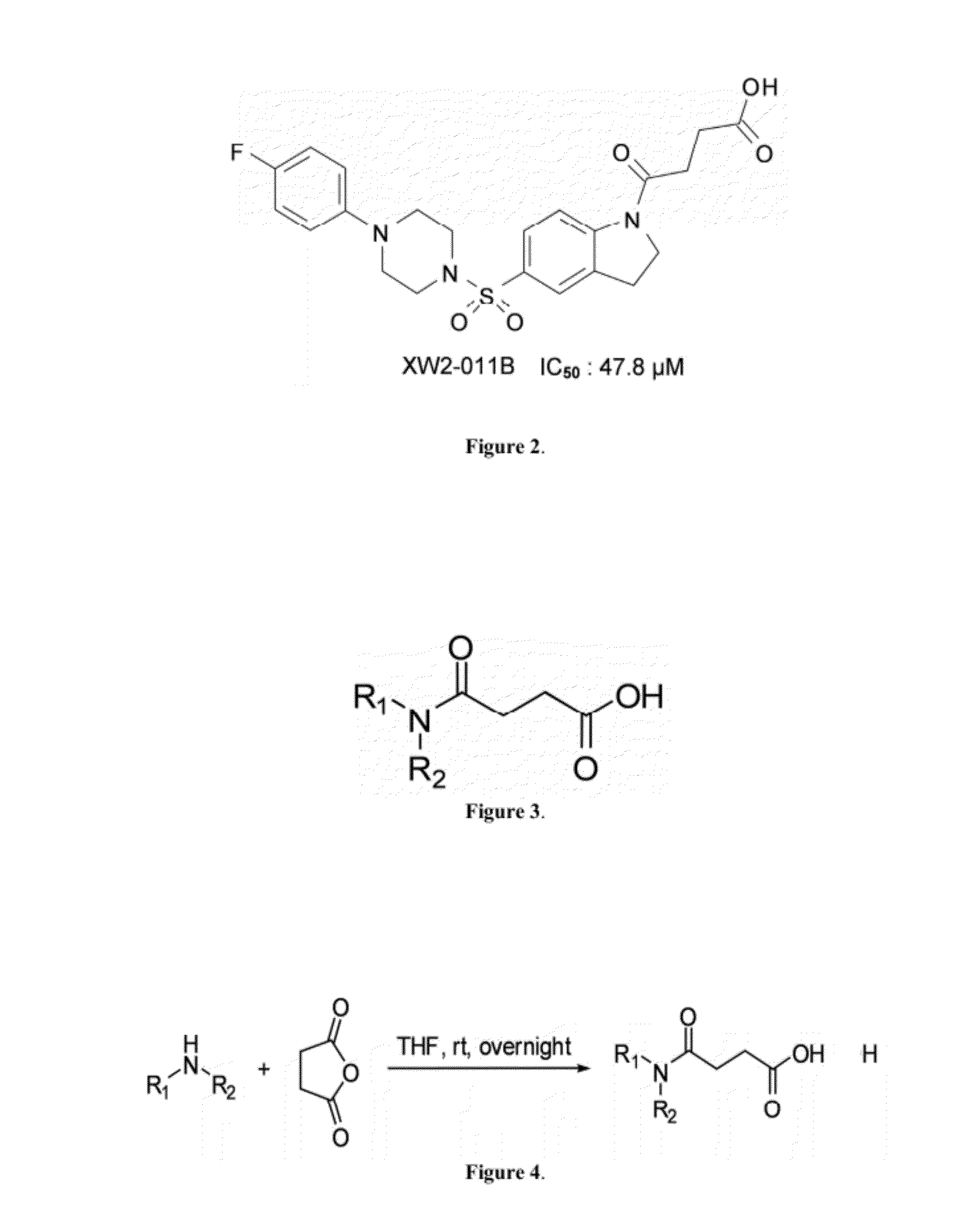Indoline scaffold shp-2 inhibitors and method of treating cancer
a technology of indoline scaffold and inhibitor, which is applied in the field of cancer therapy, can solve problems such as cancer and cancer, and achieve the effect of effective treatment methods
- Summary
- Abstract
- Description
- Claims
- Application Information
AI Technical Summary
Benefits of technology
Problems solved by technology
Method used
Image
Examples
example 1
[0079]To synthesize sulfonyl indulines of the invention, amide building blocks were first generated. Amine (5 mmol) was added drop-ise to a solution of succinic anhydride (0.5 g, 5 mmol) in anhydrous tetrahydrofuran (0.6 mL) at room temperature under argon, as seen in FIG. 3. After stirring overnight, the precipitate was collected by filtration and washed with EtOAc / hexane (1:2 by volume) to obtain crude product, which could be used directly for the next step, as described by Fuji, et al., (EP0470702 A1; 1992).
[0080]Indoline was synthesized by dissolving Indoline (12.6 mL, 0.11 mol) in dichloromethane (100 mL) at 0° C. Trifluoroacetic anhydride (29.5 mL, 0.21 mol) was added drop-wise over 1 hour. After stirring for another 1 hr, the reaction was quenched with water at 0° C. The mixture was extracted with dichloromethane, and the organic layer was washed with NaHCO3 (sat. sol.) and brine. After concentration, the solid was washed with hexane to afford crude product JF013. Product JF0...
example 2
[0095]Chemical synthesis of SPI-112 and SPI-112Me
[0096]SPI-112, seen in FIG. 12(A), was synthesized based on a hit (NSC-117199) from the NCI Diversity Set-1 in our lead optimization effort (Lawrence, et al., Inhibitors of Src homology-2 domain containing protein tyrosine phosphatase-2 (Shp2) based on oxindole scaffolds. J Med Chem 2008; 51:4948-56). In SPR binding assay, SPI-112 displayed a 1:1 stoichiometric binding kinetics to Shp2 with a kinetic constant (KD) of 1.30+0.14 μM and the association and dissociation rates of Ka=2.24×104 / Ms and Kd=0.029 / s, seen in FIG. 13. However, SPI-112 and other NSC-117199 analogs had no detectable activity in cell-based Shp2 inhibition assays, suggesting that they are not cell permeable. This is likely due to the presence of a negatively charged carboxylic acid on these Shp2 inhibitors.
[0097]SPI-112 [(Z)-3-(2-(5-(N-(4-fluorobenzyl)sulfamoyI)-2-oxoindolin-3-ylidene)hydrazinyl)benzoic acid] and SPI-112Me [(Z)-3-(2-(5-(N-(4-fluorobenzyl)sulfamoyl)-2-...
PUM
| Property | Measurement | Unit |
|---|---|---|
| Temperature | aaaaa | aaaaa |
| Temperature | aaaaa | aaaaa |
| Temperature | aaaaa | aaaaa |
Abstract
Description
Claims
Application Information
 Login to View More
Login to View More - R&D
- Intellectual Property
- Life Sciences
- Materials
- Tech Scout
- Unparalleled Data Quality
- Higher Quality Content
- 60% Fewer Hallucinations
Browse by: Latest US Patents, China's latest patents, Technical Efficacy Thesaurus, Application Domain, Technology Topic, Popular Technical Reports.
© 2025 PatSnap. All rights reserved.Legal|Privacy policy|Modern Slavery Act Transparency Statement|Sitemap|About US| Contact US: help@patsnap.com



